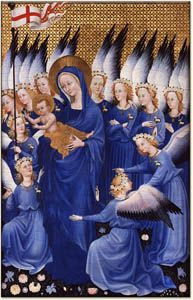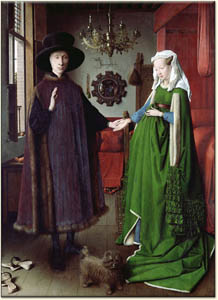Applying the Paint and the Technique of Color Modeling
The artist’s choice of paint affects both the technique of painting and how well a painting endures over time.
Egg tempera
The Wilson Diptych is a small folding altarpiece, which is presumed to have been commissioned by King Richard II of England for his private devotions. The king is portrayed kneeling in prayer and being presented by three Saints to the Virgin and Child. Although the identity of the artist is unknown, the use of egg tempera is associated with Italy and the style of the work is informed by Sienese art. On the other hand, the oak panel support and the type of white chalk ground refer to Northern European painting.
The artist of the Wilson Diptych uses egg tempera paint that dries immediately. Therefore, different paints must be pre-mixed before painting, rather than mixing paint on the surface to be painted. Adding wet paint to dry dissolves and smudges the dry paint. Thus, egg tempera paint is applied in thin strokes. The Virgin’s face is a good example of this method. Thick, heavy strokes are not possible because they crack as they lose water.
Oil paint
Van Eyck’s Arnolfini Marriage Portrait represents a prosperous and God-fearing bourgeois couple, possibly the Italian merchant Giovanni Arnolfini and his bride Jeanne de Chenany, who married in Bruges in 1434. Although it is unlikely that the painting depicts their actual marriage ceremony, it is sometimes suggested that the work is a symbolic “wedding certificate” for the couple, as their gestures refer to their union. The bride has put her right hand into her husband’s left. Similarly, he is about to put his right hand into hers. Curiously, the mirror at the back of the room reflects the scene from behind, revealing the image of the painter and another figure.
Oil paint takes days to dry and is easily blended on the surface to be painted. This allows for uniform surfaces, and is the technique used for depicting the bride in Van Eyck’s Arnolfini Marriage Portrait. Added layers do not destroy the layers underneath. Transparent, tinted layers (glazes) add subtle effects, such as depth. The unique layering technique afforded by oil paint gives the artist greater opportunities.
Oil paint has been used on stone and glass since the eighth century. During the early 15th century, Van Eyck and other Northern painters perfect the technique of oil on panel painting. Their work shows the play of light on surfaces of different textures. Oil paint ensures that the rich and brilliant colors survive almost unchanged.
Both artists have carefully constructed their paintings and the works have either a devotional or a symbolic meaning beyond their decorative function. However, the artists’ choice of paint has affected the final results of these works. The following comparison shows the differences between egg tempera and oil paint.
Comparisons
Compare these faces below. How do the ingredients in the paint affect the appearance of each painting?
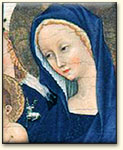
Wilton Diptych (detail), |
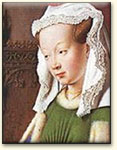
The Arnolfini Marriage Portrait |
Color modeling
Extending the range of a color from light to dark determines its brilliance and contrast, as well as the sense of depth in a painting.
In the Wilton Diptych, color modeling is achieved by color mixing. The darkest blue in the painting is achieved using the pure pigment of ultramarine. Lighter blues are achieved by pre-mixing ultramarine and white. Color is modeled from dark to light. As color mixing muddies the colors, the effect looks unnatural. Truly dark blues are absent, which makes the painting look flat.
Even if the gold leaf background is finely stippled, it fails to create an illusion of three-dimensional space. Gold leaf shining on a picture’s surface reflects the light in the viewer’s space, rather than the imaginary light within the painting. By contrast, in the van Eyck oil painting, the manner in which imaginary light (from two sources, one from the window) is depicted within the room creates the illusion of space.
The lack of spatial illusion is not a problem to the contemporary spectator of the Wilton Diptych. Typical of the late International Gothic style, the artist’s limited interest in realism is demonstrated in the details, such as the White Hart badges and circlets of flowers that are minutely described. However, the use of egg tempera has not preserved the original glory of these Rosa Gallicas, which were originally painted deep red in color and now appear pink.
Color modeling is achieved by adding colored glazes. A light green or white paint layer is progressively and selectively darkened by superimposing layer after layer of tinted, transparent glazes. Color is modeled light to dark and the result appears natural. Color glazing does not muddy the colors. The full range of green light to dark gives the painting depth, adding a third dimension.
In the Arnolfini Marriage Portrait, the illusion of depth and space is also created by the play of light, separating figures from background and the spectator. In part, this is created by the illusion of pictorial light, the interaction of the painted surface with the light that strikes it. Daylight and artificial light can now be depicted in the same painting.
How does the brilliance and the sense of depth, depicted in folds in the dresses, compare?
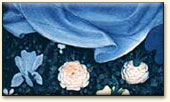
Wilton Diptych (detail), |
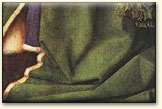
The Arnolfini Marriage Portrait |
Color modeling of shadows
Egg-tempera often fails where oil painting succeeds.
In the Wilton Diptych, the darkest tint of a color is found in the deepest shade. The egg-tempera technique requires that shadows have to be realized by color mixing. By mixing the pure pigment with black, the true color of the pigment is muddied. A clear sense of gradation is difficult to achieve, as is shown by the schematic shadows that attempt to highlight the white harps on the angels’ robes.
In the Arnolfini Marriage Portrait, oil paint makes the darkest tint of a color achievable with transparent color glazes. Selective tinting provides a convincing gradation of contrast in cast shadows, as is seen in the bride’s shoes.
It is generally said that paintings like the Wilton Diptych (classified as International Gothic style) achieve a greater realism. Bearing in mind what you have read about the limitations of tempera, look closely at the painting itself. This question is less color-related, but important! (The fact that the Virgin is shown as unnaturally tall is a convention in art of the period: she is the Queen of Heaven!)
The early 15th-century artist Alberti wrote of the advantages of “imitating…gold with colors…” Why do you think he said that?

Wilton Diptych (detail), |

The Arnolfini Marriage Portrait |
Color modeling of faces (flesh tones)
Many faces in religious paintings look green today – but only in those paintings where the artist utilizes egg tempera. The comparison between Nardo di Cione’s St. John the Baptist with St. John the Evangelist and St. James and Jan Van Eyck’s Margaretha Van Eyck is a good example of the contrast in how different mediums withstand the test of time.
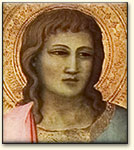
St. John the Baptist with St. John the Evangelist and St. James (detail), Nardo di Cione, c. 1365 Egg tempera on wood. Over the centuries, faces in egg tempera paintings begin to look green. |
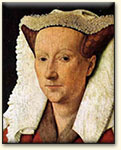
Margaretha Van Eyck (detail), |
Egg tempera and flesh tones
Faces are painted in egg tempera by over-painting, that is, by applying one layer over another. Nardo di Cione’s St. John the Evangelist demonstrates the instability of over-painting in egg tempera. Today, the faces have degraded and the flesh tones have become more transparent with time. The ground is of white gesso (a chalk mixed with size, or glue), but it was common practice to cover this with a thin under-painting of terra verde (green earth) or verdaccio, a mixture of greenish-brown or yellow pigments on top of which flesh colors are thinly superimposed using a red lake (dye). Red and green are complementary colors, so the green tint is used to accentuate the delicate flesh tint. Today, the unstable red dye has become transparent, bleached by the illumination of centuries, and only the green tint remains.
Oil paint and flesh tones
During the 15th century, faces are modeled in oil on a pure white background, and modulated with a progressive series of flesh tone glazes in a carefully graded manner. These flesh pigments are not unstable. The face of Margaretha Van Eyck remains naturally defined today, with no hint of green coloration. In the painting above, a greater contrast is found in the flesh tones, illustrating the greater sense of realism found in oil paintings.
Differently colored grounds were used in successive centuries, on panel as on canvas. They range from buff to red or ochre-tinged browns in the 17th century, to grays, and, in the case of El Greco (1541-1614), a ground that was almost black. These could be used to create varying effects, and also to “stand” for shadows or half-shadows (where grey-green is used) without superimposing further layers of paint. Some more fugitive colors can also fade, even when oil is used as a medium, as happened with the Lake colors in some of Sir Joshua Reynolds’ (1723-1792) portraits.
